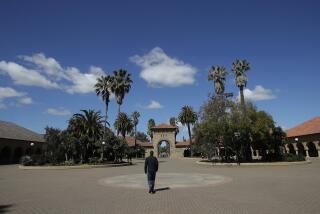Untangling an argument for affirmative action
It looks bad for the University of Texas after Wednesday’s oral arguments at the Supreme Court about the university’s affirmative action program. Even if the court doesn’t overturn a 2003 decision allowing some consideration of race in college admissions, questions from several justices -- including Anthony M. Kennedy, who dissented in the 2003 case but is open to some use of race in admissions -- suggested that they thought UT went too far.
The UT program allows admissions officers to consider race in filling places in the freshman class left over after the acceptance of students who finished at the top of their high school graduating classes. The so-called Top 10% program (it now covers students who finish in the top 8%) has produced considerable racial diversity, partly because Texas high schools are so segregated, but UT also wants to tap African American and Latino applicants from competitive integrated schools who didn’t make the top 8%.
Whatever the outcome, Wednesday’s argument offered a primer in the paradoxes, contradictions and intellectual evasions that define the debate over affirmative action. Under the court’s 2003 decision, which involved the University of Michigan law school, a university may consider an applicant’s race as “one factor” among others in assessing whether the candidate would contribute to a diverse learning environment. Although applicants are to be considered individually, universities are allowed to seek a “critical mass,” an undertaking that by definition involves keeping an institutional eye on gross numbers.
Competitive universities like UT aim to enroll a significant number of racial minorities for a variety of reasons: to ensure that African Americans and Latinos graduate from institutions that serve as feeders for leadership positions in society; to compensate for historic discrimination that is believed to explain the lower grades and test scores of some minority applicants; and, last and probably least important, to enhance the educational experience of non-minority students.
Of all of these justifications, the first -- to ensure that African Americans and other minorities are represented in elites -- is both the most compelling as a matter of public policy and the hardest to reconcile with the court’s precedents, which prohibit racial quotas. Unable to argue that racial diversity in elite institutions is a good in itself, UT and other universities have to resort to increasingly convoluted arguments about its educational value.
For example, UT aims to promote “diversity within diversity” by granting preferences to the children of African American professionals who didn’t finish in the top tier of their class at their integrated high schools. The theory behind diversity within diversity is that the presence in a classroom of racial minorities of different socioeconomic backgrounds serves the educational purpose of alerting non-minority students to the fact that all minorities aren’t poor. (Or that they all don’t play basketball: In supporting UT, Solicitor General Donald Verrilli Jr. said that admissions officers might want to grant admission to “individuals who will play against racial stereotypes just by what they bring, [such as] the African American fencer.”
The diversity within diversity argument seemed to scandalize Kennedy. “You want underprivileged of a certain race and privileged of a certain race,” he told the university’s lawyer. “So that’s race.” To which the lawyer should have been able to reply: “Well, duh. Of course it’s about race. We want these bright but non-Top 10% black students because they are probably more likely to graduate (and go on to law school and the Texas legislature) than some of the black students who finished in the top 10% of the class in substandard schools.” But that straightforward answer is foreclosed by two legal fictions: that the overriding goal of affirmative action is educational and that race is only “one factor.”
Ideally, the court would both uphold affirmative action and dispose of these artificial and unconvincing rationales for it. But that’s probably the least likely outcome of the Texas case.
ALSO:
A high-stakes battle for higher education
California gas prices to tumble? Just my luck
More to Read
A cure for the common opinion
Get thought-provoking perspectives with our weekly newsletter.
You may occasionally receive promotional content from the Los Angeles Times.











